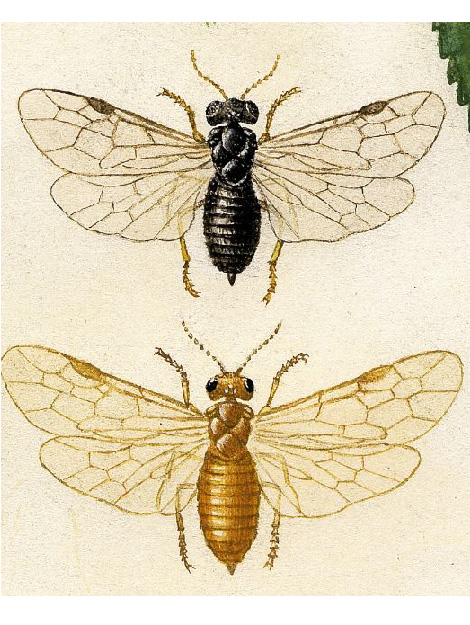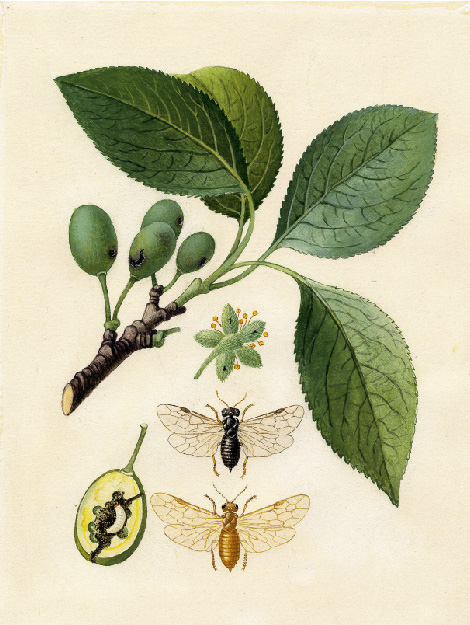Plum sawfly
Hoplocampa minuta and Hoplocampa flava
Appearance

Two species of the plum sawfly occur damagingly:
the black or small plum sawfly(Hoplocampa minuta Christ.) and the yellow plum sawfly(Hoplocampa flava L.).
Adults are about 4-5 mm and 6 mm long, respectively, and are black and amber-yellow in ground coloration (see species names).
The whitish-yellow sawfly larvae have ten pairs of legs, a brown head capsule and grow to 9-11 mm in length.
Biology
Plum sawflies fly at the time of plum blossom, whereby flight time and egg laying depend on the weather. Each female lays up to 70 eggs with the aid of a saw-like ovipositor (saw wasp!) on the abdomen individually in slits in the tips of the calyxes or on the young fruits (from 4 mm in size) in small pockets. After about ten to twelve days, the larvae hatch and bore into the young fruit, where they feed on the flesh and kernel for about nine days before attacking neighboring fruit. During further development, each larva can damage up to five fruits in this way, which drop prematurely. After four to six weeks of development and four molts, the last larval stage falls to the ground with the last infested fruit and hibernates in a brown cocoon 10-15 cm deep in the soil. In spring, pupation occurs and after two weeks the adults hatch just before the host plants begin to flower. The life span of the adults is about two weeks. Only one generation is formed per year.
Damage symptoms
When infested by plum sawflies, the fruit, which is barely 2 cm in size and still green, has one or two boreholes that are plugged with black, moist fecal crumbs. In the infested fruits, the pit and pulp are destroyed. Sometimes the larvae of sawflies can be found, which spread an intense bug smell. The damaged fruits fall prematurely from the trees.

Prevention and control
- A preventive measure is the selection of less sensitive cultivars in infested areas (e.g. early or late flowering).
- If infestation is detected, the infested fruits should be regularly shaken off the tree, collected and destroyed in home and small gardens.
- To predict the occurrence and monitor the flight intensity of adult sawflies, white glue boards can be hung in the crown area of trees a few days before flowering begins (around April). The white boards should be checked several times a week. If sufficient numbers are present, the white boards can also be used for mass interception of plum sawflies, which may reduce infestations. The white boards should only be used during the sawfly flight period (approximately one week before to one week after flowering) in order to protect the natural counterparts of the plum sawflies.
- The damage threshold is four to eight egg deposits per 100 fruit calyxes or 2-6% of infested young fruit.
- Control with plant protection products can be carried out immediately after flowering or in the outgoing flower (see list of plant protection products approved in Austria).
Last updated: 28.10.2024
automatically translated